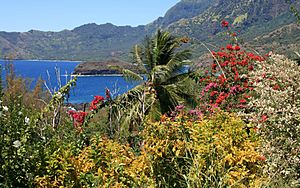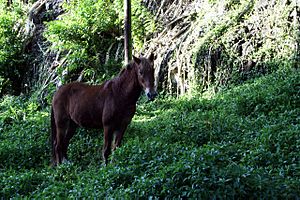Hiva Oa facts for kids
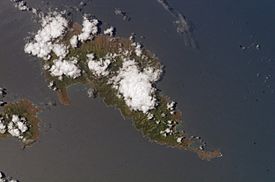
The island of Hiva Oa. Atuouna is located on the large bay on the south side of the island.
|
|
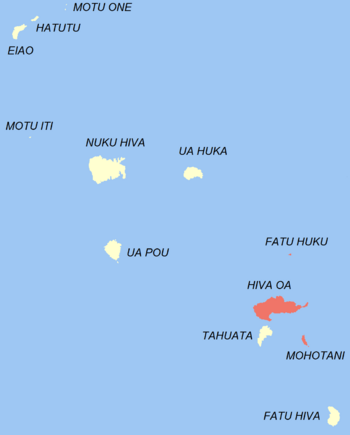
Location of Hiva Oa within the Marquesas Islands
|
|
| Geography | |
|---|---|
| Location | South Pacific Ocean |
| Coordinates | 9°45′S 139°00′W / 9.750°S 139.000°W |
| Archipelago | Marquesas Islands |
| Area | 316 km2 (122 sq mi) |
| Highest elevation | 1,213 m (3,980 ft) |
| Highest point | Temetiu |
| Administration | |
| Overseas country | French Polynesia |
| Demographics | |
| Population | 2,190 (2012) |
| Pop. density | 6.9 /km2 (17.9 /sq mi) |
Hiva Oa is a beautiful island in the Marquesas Islands, which are part of French Polynesia. This area is a territory of France located in the Pacific Ocean. Hiva Oa is the second largest island in the Marquesas, covering about 320 square kilometers (124 square miles).
It is the biggest island in the southern Marquesas group. About 2,200 people live on Hiva Oa. The island's highest point is a volcano called Temetiu, which stands about 1,200 meters (3,937 feet) tall.
Contents
Exploring Hiva Oa: What Makes It Special?
Hiva Oa is known for its stunning natural beauty. It has steep cliffs that rise straight from the ocean. The island also has rugged mountains and deep, hidden valleys. Unlike many other islands in the Pacific, Hiva Oa does not have coral reefs protecting its shores. This means the ocean waves crash directly onto the coast.
Where is Hiva Oa Located?
Hiva Oa is part of the Marquesas Islands in French Polynesia. It is located in the South Pacific Ocean. The island is about 9 degrees south of the equator and 139 degrees west longitude.
What is the Main Town?
The main town on Hiva Oa is Atuona. It is located on the coast and serves as the administrative center for the area. Atuona used to be the capital for all the Marquesas Islands. Now, the capital is Taiohae on Nuku Hiva island.
Famous Residents of Hiva Oa
Hiva Oa is famous because two well-known artists lived their final years here.
- The French painter Paul Gauguin
- The Belgian singer Jacques Brel
Both artists are buried in Calvary Cemetery. This cemetery is on a hill overlooking Atuona.
Ancient History of Hiva Oa
Before Europeans arrived, Hiva Oa was divided into two main areas. These were Nuku in the west and Pepane in the east. The first Europeans to see Hiva Oa were from a Spanish expedition led by Álvaro de Mendaña de Neira. This happened on July 21, 1595. They named the island Dominica.
Geography and Nature of Hiva Oa
Hiva Oa is the largest and most fertile of the southern Marquesas islands. It is second in size only to Nuku Hiva. The island's landscape is very dramatic. It features steep cliffs and a spine of volcanic mountains. There are also many deep, isolated valleys.
Getting Around Hiva Oa
Because of the rugged coastline, travel along the shore is mostly by boat. There are some dirt roads that cross the island's interior. These roads connect the small villages and settlements. Atuona Airport is located on a plateau in the middle of the island. It has a paved runway about 1,215 meters (3,986 feet) long. There are daily flights to other Marquesas islands and Tahiti.
The Collapsed Volcano: Temetiu
A key feature of Hiva Oa's geology is the collapsed volcano, Temetiu. The semi-circular Ta'a Oa bay, also known as the Bay of Traitors, sits inside the volcano's crater. The walls of the crater rise sharply about 1,000 meters (3,280 feet) above the bay. Inside Ta'a Oa, you'll find Atuona Bay and Taha Uku. These are the best places to anchor a boat on the island.
The Channel to Tahuata
Hiva Oa is separated from the nearby island of Tahuata by a channel. This channel is about 2.5 miles (4 kilometers) wide. It is called Ha'ava or the Canal de Bordelais.
Climate of Hiva Oa
The temperatures in the Marquesas Islands stay warm all year round. However, the amount of rain can change a lot. The northern and eastern parts of the islands get much more rain. These are the "windward" sides. The western, "leeward" sides get less rain. Sometimes, there are droughts that can last for several years. These droughts often happen during El Niño events.
| Climate data for Hiva-Oa (1991−2020 normals, extremes 1939−present) | |||||||||||||
|---|---|---|---|---|---|---|---|---|---|---|---|---|---|
| Month | Jan | Feb | Mar | Apr | May | Jun | Jul | Aug | Sep | Oct | Nov | Dec | Year |
| Record high °C (°F) | 35.3 (95.5) |
35.0 (95.0) |
35.0 (95.0) |
35.0 (95.0) |
34.7 (94.5) |
33.8 (92.8) |
33.0 (91.4) |
32.6 (90.7) |
34.2 (93.6) |
34.7 (94.5) |
35.0 (95.0) |
36.1 (97.0) |
36.1 (97.0) |
| Mean daily maximum °C (°F) | 31.2 (88.2) |
31.5 (88.7) |
31.5 (88.7) |
31.2 (88.2) |
30.5 (86.9) |
29.6 (85.3) |
29.0 (84.2) |
29.0 (84.2) |
29.6 (85.3) |
30.4 (86.7) |
30.9 (87.6) |
31.1 (88.0) |
30.5 (86.9) |
| Daily mean °C (°F) | 27.3 (81.1) |
27.6 (81.7) |
27.8 (82.0) |
27.6 (81.7) |
27.1 (80.8) |
26.4 (79.5) |
26.0 (78.8) |
25.8 (78.4) |
26.2 (79.2) |
26.6 (79.9) |
26.9 (80.4) |
27.2 (81.0) |
26.9 (80.4) |
| Mean daily minimum °C (°F) | 23.4 (74.1) |
23.7 (74.7) |
24.0 (75.2) |
24.0 (75.2) |
23.7 (74.7) |
23.3 (73.9) |
22.9 (73.2) |
22.6 (72.7) |
22.7 (72.9) |
22.7 (72.9) |
23.0 (73.4) |
23.3 (73.9) |
23.3 (73.9) |
| Record low °C (°F) | 19.2 (66.6) |
18.3 (64.9) |
19.9 (67.8) |
19.8 (67.6) |
19.2 (66.6) |
18.5 (65.3) |
17.7 (63.9) |
16.8 (62.2) |
18.0 (64.4) |
18.0 (64.4) |
18.6 (65.5) |
17.5 (63.5) |
16.8 (62.2) |
| Average precipitation mm (inches) | 134.4 (5.29) |
116.1 (4.57) |
178.2 (7.02) |
170.2 (6.70) |
135.7 (5.34) |
151.7 (5.97) |
151.2 (5.95) |
121.1 (4.77) |
87.9 (3.46) |
87.1 (3.43) |
94.1 (3.70) |
68.6 (2.70) |
1,496.3 (58.91) |
| Average precipitation days (≥ 1.0 mm) | 12.6 | 12.8 | 15.2 | 13.6 | 14.4 | 14.9 | 16.4 | 14.8 | 11.9 | 12.0 | 11.7 | 9.9 | 160.1 |
| Mean monthly sunshine hours | 219.2 | 202.3 | 210.5 | 196.3 | 194.1 | 172.7 | 174.6 | 185.7 | 197.9 | 222.4 | 214.1 | 228.1 | 2,417.8 |
| Source: Météo-France | |||||||||||||
| Climate data for Atuona, Hiva Oa | |||||||||||||
|---|---|---|---|---|---|---|---|---|---|---|---|---|---|
| Month | Jan | Feb | Mar | Apr | May | Jun | Jul | Aug | Sep | Oct | Nov | Dec | Year |
| Mean daily maximum °C (°F) | 30 (86) |
31 (87) |
31 (87) |
31 (87) |
29 (85) |
29 (84) |
28 (83) |
28 (83) |
29 (84) |
29 (85) |
30 (86) |
30 (86) |
29 (85) |
| Daily mean °C (°F) | 27 (81) |
27 (81) |
28 (82) |
28 (82) |
27 (80) |
26 (79) |
26 (78) |
26 (78) |
26 (79) |
26 (79) |
27 (80) |
27 (81) |
27 (80) |
| Mean daily minimum °C (°F) | 23 (74) |
24 (75) |
24 (76) |
24 (76) |
24 (75) |
23 (74) |
23 (74) |
23 (73) |
23 (73) |
23 (73) |
23 (74) |
23 (74) |
23 (74) |
| Average precipitation mm (inches) | 110 (4.5) |
91 (3.6) |
110 (4.4) |
120 (4.6) |
120 (4.8) |
180 (6.9) |
120 (4.8) |
100 (4) |
160 (6.2) |
79 (3.1) |
66 (2.6) |
89 (3.5) |
1,290 (50.9) |
| Source: Weatherbase | |||||||||||||
Geology: How Hiva Oa Was Formed
Hiva Oa is a volcanic island. It was formed by a hot spot on the Pacific Plate. This plate is slowly moving west-northwest. The rocks on the island are between 1.63 and 4.26 million years old. Even today, you can see signs of volcanic activity. There are mud pots and small solfataras (vents releasing volcanic gases) near the road from Atuona to Taaoa.
Flora: Plants of Hiva Oa
Hiva Oa has a lot of different plant species, which is called biodiversity. There are 205 types of plants that naturally grow here. About 24 of these are found only on Hiva Oa. There are also 178 types of plants that were brought to the island by people.
Ferns are very common on the island. They grow in the wet, shady parts of the valleys. Some ancient native plants include the coconut palm and the screw tree. These are found in the lower areas. Plants like breadfruit trees and Tahitian chestnuts were brought by early Polynesian settlers. They are now common in the low and middle parts of the island. Bamboo, which is not native, has grown into large groves in some places. This can be a problem for the native plants.
In the higher, harder-to-reach areas, the natural plant life remains almost untouched. The northern side of the island is drier because the mountains block the wind and rain.
Fauna: Animals of Hiva Oa
The animal life on the Marquesas Islands is mostly made up of land and sea birds, insects, reptiles, butterflies, and spiders. The Marquesas warbler is a bird found only on Hiva Oa and the nearby island of Tahuata. There are no animals on the island that are dangerous to humans. However, there is a type of black fly called the nono fly. It can be very annoying, especially in the island's interior.
People and Culture of Hiva Oa
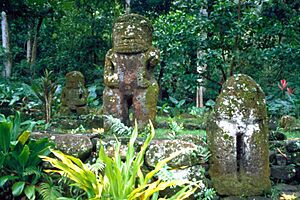
In 2012, about 2,190 people lived on Hiva Oa. Most of them lived in the area of Acounda, and a smaller number lived in Puama'u village. The people speak the southern Marquesan language, which is related to other Polynesian languages. They also speak French.
Religion on Hiva Oa
Most of the people on Hiva Oa are Christian. This is because of the work of Catholic missionaries. The Catholic Church has six churches on the island. These include the Church of the Immaculate Conception in Atuona and the Church of Saint Anne in Hanaiapa.
According to local stories, the gods created the Marquesas Islands as their home. Each island's name is related to building a house. For example, Hiva Oa means "long ridge."
Economy and Daily Life
The economy of Hiva Oa is mainly based on Subsistence agriculture. This means people grow food and raise animals for their own use. They fish, raise pigs and chickens, and grow crops like breadfruit, coconut, yams, and bananas. Some copra (dried coconut meat) is grown to be sold to other places. Tourism is also important, even though it is still small. It provides some jobs on the island. The money used here is the CFP franc, which is linked to the euro.
Infrastructure and Services
Some settlements on Hiva Oa are connected by paved roads. However, these roads are often steep and winding. So, many people still prefer to travel between villages by boat. The western part of the island and the mountainous interior are mostly undeveloped.
The airport on the Tepuna plateau has a paved runway. It is connected to Atuona by a winding road.
Atuona has good services for its size. It has a hospital, medical and dental offices, and a post office with satellite phone service. There is also a bank with an ATM, a police station, and a courthouse. For education, there are schools for young children and a high school. Atuona also has a Catholic Church and a Protestant church. For visitors, there is a hotel, small guesthouses, restaurants, and bars.
Large cruise ships can enter Atuona Bay. They usually anchor, and passengers take smaller boats to shore. Regular supply ships from Tahiti also dock at the harbor pier.
Places to Visit on Hiva Oa
Hiva Oa has many interesting places to explore, especially for those interested in history and art.
Ancient Stone Statues at Puamau
The village of Puamau is about 45 kilometers (28 miles) from Atuona. It's a two-and-a-half-hour drive on a steep, winding road. On the edge of the village, there is a large ceremonial platform. It is said to be the burial place of Queen Vahine Titoiani. You can see large stone tiki sculptures carved into two corners of the platform.
In the Puamau valley, about two kilometers from the coast, is Ipona (also called Oipona). This is the largest and most important historical site in the Marquesas. This valley was once home to a powerful tribe called Naiki. After a conflict, another tribe took revenge and wiped out the Naiki. The winners then put a special restriction (called a tapu) on Ipona and set up tikis there. After Christianity came to the island, this ancient worship place was no longer used.
The Marae Takii is a well-restored site with three terraces. It has 8 stone statues and large stone heads. The biggest statue is Tiki Takai'i, which is 2.43 meters (8 feet) tall. It is believed to be the guardian spirit of the valley. Another unique statue is Maki'i Taua Pepe. Some people think it shows a priestess or goddess giving birth. Others believe it looks more like an animal swimming.
Taaoa Valley: A Place of Ancient Power
The Taaoa Valley, west of Atuona, is filled with huge banyan trees, coconut palms, and many fruit trees. This valley was once controlled by the powerful Tiu tribe. They are important in Hiva Oa's traditional stories. Many buildings were built here. In the center is a tohua, which is the largest ceremonial plaza in the Marquesas. A large tiki stands in the plaza, and a stone head is on one of the ceremonial platforms. Terraces for growing taro have also been found nearby.
Eiaone Valley: Rock Carvings
The Eiaone Valley, west of Puamau, is famous for its unique rock carvings, called petroglyphs. These carvings are semi-relief, meaning they stick out slightly from the rock. Many of them are covered by thick plants. Other petroglyphs, stone images, and platforms can be found in the Tahauku and Punae valleys, east of Atuona.
Paul Gauguin and Jacques Brel Cultural Sites
The Atuona cultural center is dedicated to the painter Paul Gauguin. It shows copies of his paintings and tells the story of his life in the South Seas. His house next door has been rebuilt.
There are also items related to Jacques Brel in Atuona. In 2003, a special hangar was built for his airplane, a Beechcraft D 50 Twin-Bonanza, nicknamed "Jojo." The plane has been restored. You can also see photos and documents from Brel's years in the South Seas. A monument to Jacques Brel stands at a viewpoint on the airport road.
Calvary Cemetery: Final Resting Place
The Calvaire Cemetery (Cimetière Calvaire) is located above Atuona. It is where Paul Gauguin and Jacques Brel are buried. Some people wonder if Gauguin's grave is truly marked, as it is said he was buried without a marker somewhere in the jungle. The cemetery is a popular spot for visitors. It offers amazing views of Taaoa Bay.
Images for kids
- Haʻava
- Dependent Territory
See also
 In Spanish: Hiva Oa (isla) para niños
In Spanish: Hiva Oa (isla) para niños


